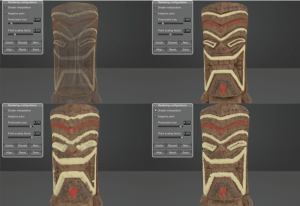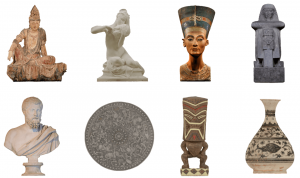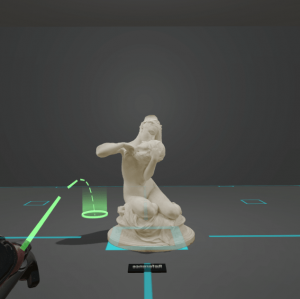We explore the use of virtual reality in subjective quality evaluation of point cloud contents [1]. For this purpose, we develop the PointXR toolbox, a software that is built in Unity for rendering and visualization of 3D point clouds in virtual environments. Moreover, we generate and release the PointXR dataset, a point cloud repository that consists of 20 high-quality cultural heritage models. Finally, we publish the PointXR experimental data, stimuli and quality scores collected from a subjective evaluation campaign in virtual reality to assess the performance of the state-of-the-art MPEG Geometry-based Point Cloud Compression (G-PCC) color encoders under two evaluation protocols, using our software and dataset.
In this webpage, we make publicly available relevant material, organised as follows:
- PointXR toolbox: Software that consists of a set of 3D Unity scenes, developed to: (a) adjust the visual appearance of point clouds by enabling different rendering configurations, and (b) host experiments under variants of interactive and passive evaluation protocols. In our software, the default Pcx point cloud importer and renderer for Unity is enhanced with: (i) adaptive point size, (ii) square shader, and (iii) shader interpolation.

Example of the toolbox scene for adjusting the
rendering configurations of a model
- PointXR dataset: Repository consisting of 20 high-quality point clouds representing cultural heritage, generated from publicly available mesh models. The point clouds were generated after texel sampling applied on the mesh models in Meshlab using a texture resolution of 4096×4096 (WxH).

Sample models from the PointXR dataset
- PointXR experimental data: Stimuli and subjective scores obtained from quality evaluation experiments that were conducted to assess the performance of the color encoding modules integrated in the MPEG G-PCC codec (i.e., Lifting and RAHT). The experiments were performed in Virtual Reality (VR) allowing 6 degrees of freedom (6-DoF) interactions between the subjects and the stimuli, using the PointXR toolbox. Two variants of a Double-Stimulus Impairment Scale (DSIS) methodology were adopted, namely, DSIS sequential and DSIS alternating. A set of 5 models from the PointXR dataset were selected and encoded using the Octree encoding module for geometry and following the MPEG Common Test Conditions.

User inspecting a model interactively
*Credits to the original creators, license attribution, and modifications are indicated per model in a README file coming with each dataset.
Download
– The PointXR toolbox can be downloaded from the following GitHub repository.
– The PointXR dataset and/or the PointXR experimental data can be downloaded from the following FTP by using dedicated FTP clients, such as FileZilla or FireFTP (we recommend to use FileZilla):
Protocol: FTP
FTP address: tremplin.epfl.ch
Username: [email protected]
Password: ohsh9jah4T
FTP port: 21
After you connect, choose the PointXR folder from the remote site, and download the relevant material.
The total size of the provided data is ~3.7 GB. Each dataset can also be downloaded separately (~3.4 GB the PointXR dataset, ~0.3 GB the PointXR experimental data).
Please instruct the README files for further information on the structure and the usage of the material.
You may also read [1] for more details about the software and the experiment.
Conditions of use
If you wish to use any of the provided material in your research, we kindly ask you to cite [1].
References
- E. Alexiou, N. Yang and T. Ebrahimi, “PointXR: A Toolbox for Visualization and Subjective Evaluation of Point Clouds in Virtual Reality,” 2020 Twelfth International Conference on Quality of Multimedia Experience (QoMEX), Athlone, Ireland, 2020, pp. 1-6. doi: 10.1109/QoMEX48832.2020.9123121.